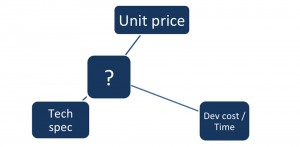Assessing technical design trade-offs during product development
While fast time-to-market, low product cost and high-quality technical specification are all key factors when launching new products, the process of making design decisions usually involves a trade-off between software and hardware.
Electronics is an art. Give multiple engineers the same specification and they will often create multiple different solutions that meet the specification perfectly. One design engineer may have considered unit cost as the most important factor while another will have designed the product to minimise development cost.
For a winning design that meets all its requirements, the design engineer needs to balance all three factors of technical specification, development cost and unit price, taking the following considerations into account from the start:
- Time to market
- Available development budget
- Target market sale price
- Anticipated sales volumes
- Value in exceeding or modifying the specification
As many of these factors can be little more than wild guesses, they can skew a design engineer’s decisions – particularly when the expected volume is unknown. Here, initial planning for the product, where units will be built in large numbers, means that the focus is on unit cost. However, if time to market is key then the design engineer may decide to use off-the-shelf, modular hardware, at the expense of unit price and technical specification.
A design engineer’s choice of components can have a major impact on the time taken to develop the software. In embedded designs, using more costly components such as modular microprocessor solutions with production-ready board support packages, rather than creating a design with components and reference software only, helps cut the software development time, and vice versa. This often leads to a straight fight between development time and unit cost. When deciding which trade-offs to make, the design engineer’s first priority must always be to identify exactly what is being traded though.
Figure 1 represents a product development process that would result in an over-engineered and expensive product, which would nonetheless last longer than a lower-cost, less-developed alternative.
Figure 1 Without any guidance, design engineers are likely to focus on technical specifications (best technology and features) over the unit cost and/or development time
Understanding project risk is also important as design engineers consider the technical design trade-offs. The development cost of a product is typically directly proportional to the time it takes so, when overruns happen, you’re being hit twice – once by rising costs and once by a lengthening time to market.
Fixed-price contracts, where the development team foot the bills for any overruns for which you are not responsible, can minimise project risk. Another approach is to use third-party software libraries, which may reduce software development time but increase unit cost.
To minimise the bill-of-materials cost often involves allowing a degree of experimentation, which takes an uncertain amount of time. There are various risks with this approach: to the customer’s timescale; to the contractor who has quoted a fixed price yet faces unknown costs; and to engineering teams who face similarly uncertain internal costs. To this end, optimising the bill of materials cost is often best done after the technical design goals have been met, so that the impact on time to market is reduced.
Making decisions about product development can appear to be a circular process, as a design team gradually narrows its focus on to the best platforms to use. At each stage, you may find that making a decision that improves one factor has adverse effects on another. The best moment in product development is when a decision you take actually helps voercome multiple problems at once. Then you can say you have truly learnt the art of the trade-off.
Author
Dunstan Power is director of ByteSnap Design. Power is a chartered electronics engineer who graduated with a degree in engineering from Cambridge University. He has been working in the electronics industry since 1992. In 2004, Power founded Diglis Design, an electronic design consultancy, where he developed many electronic board and FPGA designs. In 2008, Power teamed up with former colleague Graeme Wintle to establish ByteSnap Design, which supplies integrated software development and embedded design services.
 Dunstan Power is director of ByteSnap Design, which supplies integrated software development and embedded design services.
Dunstan Power is director of ByteSnap Design, which supplies integrated software development and embedded design services. 